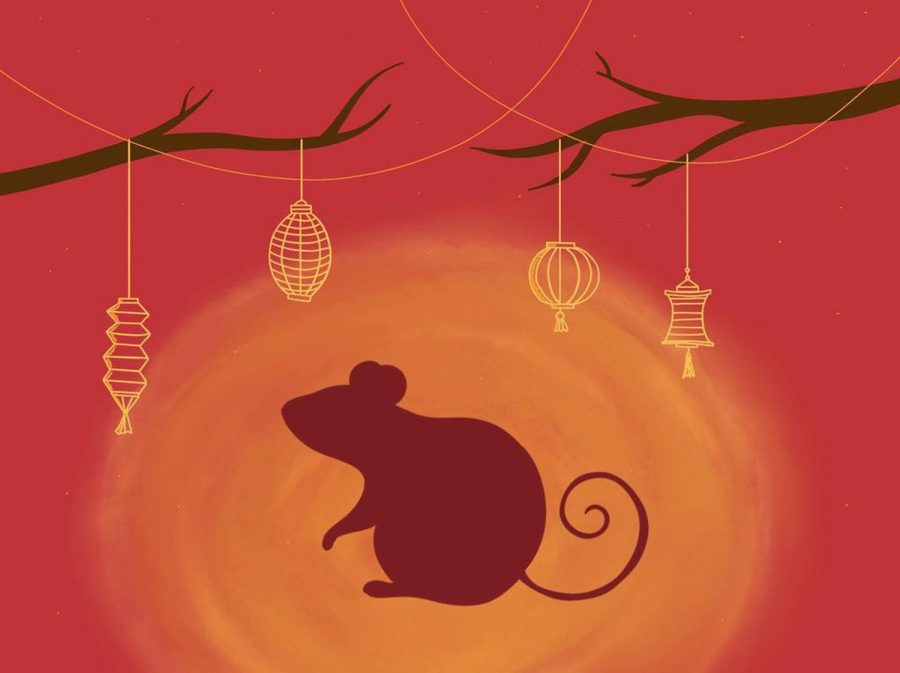Lunar New Year 2020: Ringing in the Year of the Rat
Shruti Talekar | Staff Illustrator
Jan. 25 marked the start of the Year of the Rat on the lunar calendar.
January 27, 2020
Pitt students and faculty stepped away from their dreary, beige cafeteria and break-room lunches to usher in the New Year among false cherry blossoms and pops of red.
The festivities were part of the annual Lunar New Year celebration hosted by the Institute for International Studies in Education from their temporary location on McKee Place. The event was one of many gatherings held throughout Pittsburgh to mark the start of the Year of the Rat on the lunar calendar, which officially began Jan. 25.
Unlike the Gregorian calendar, with which most Americans are most familiar, the lunar calendar tracks time based on the cycles of the moon rather than the movement of the earth around the sun. Yiting Chen, a Chinese instructor at Pitt, said this system has its roots in ancient agrarian practices.
“Ancient Chinese people used [the lunar calendar] to track what to plant in their fields, so this is the way they functioned [with the cycles of the moon] back in the old days,” she said.
Although the Lunar New Year is often referred to as “Chinese New Year,” the holiday is celebrated in countries all across Asia, including Vietnam, Korea and Indonesia. Featuring food from a range of cultures — like Banh Tet, a staple food of the Vietnamese celebrations — Thursday’s event was a pan-Asian celebration aimed at celebrating diversity, according to IISE director Maureen McClure. She said the festivities were planned almost entirely by students, who come from a broad range of backgrounds.
“The organization, the planning, the invitations — everything is pretty much done by students,” McClure said. “And that’s really important because we have a very diverse group of people that work with IISE.”
Decor for the event was primarily red, the traditional color of the New Year. Chen said families decorate their homes in red because of an ancient Chinese myth, similar to the story of the zodiac. According to the story, a monster named Nian emerged only during the new year to terrorize humans until an old man sent by the gods revealed that Nian was afraid of the color red.
“Nian only comes out once a year, which is the time of the Chinese New Year,” Chen said. “[People] put red things outside their house and write some blessings [on signs] on New Year’s Eve to scare Nian away.”
Thursday’s celebration also featured Chinese-language music performed by IISE program coordinator and education instructor Jorge Enrique Delgado. Delgado is from Colombia, but said he was inspired by his students and colleagues to start learning songs in Chinese.
“I only know a few words in Chinese,” he said. “I learned my songs from [students and classmates], and they improved my pronunciation, and they taught me the meanings [of the lyrics].”
Each year in the Chinese lunar calendar is represented by one of 12 animals, the first of which is the rat. According to Chen, a popular Chinese legend says that the gods held a race to determine which animals would represent which years. The rat knew he couldn’t beat the cat, so he decided not to tell the cat about the race in order to win for himself. Chen said this legend explains both why the rat is the first animal in the Chinese zodiac and why cats appear to hate rats.
Still, the rat is associated with more than just deceit. According to Chen, the rat is known for his speed and cunning, and the Year of the Rat brings careful planning and increased wealth.
“Even though in this story, the rat is not a good symbol because he cheated his friends, the rat is fast and agile, and in the Year of the Rat, you will have a very meticulous year,” she said. “And rats also bring fortune and money.”
Although the official date of the Lunar New Year has already passed, there are still opportunities to enjoy New Year’s festivities and support Asian culture in Pittsburgh. Marian Lien, the president of the Organization of Chinese Americans, said there will be two events in early February that focus on the New Year. Artist Jordan Wong, whose work combines traditional New Year themes with questions of Asian identity, will host a talk at MuseumLab in the North Side on Feb. 8 at 3 p.m., during which he will discuss his experiences navigating a creative career.
Lien said it’s important for artists like Wong to engage in dialogue about their background because they may not be actively encouraged to pursue creative fields.
“Society has these stereotypes about what Asian Americans are,” she said. “And not just the greater society, but with our own communities not knowing how to support our artists.”
The OCA is also putting on a parade showcasing 25 Asian cultural organizations, including Thai dancers and representatives of the Pittsburgh Dragon Boat Festival on Feb. 9 in Squirrel Hill. Lien said the parade is an opportunity for Asian Americans in Pittsburgh to come together and forge a deeper sense of community.
“Any organization that has a tie with the Asian community will be coming out, showcasing who they are, and celebrating with the community,” Lien said. “My hope is that Pitt students will find it inspiring to come out and support these individuals.”








